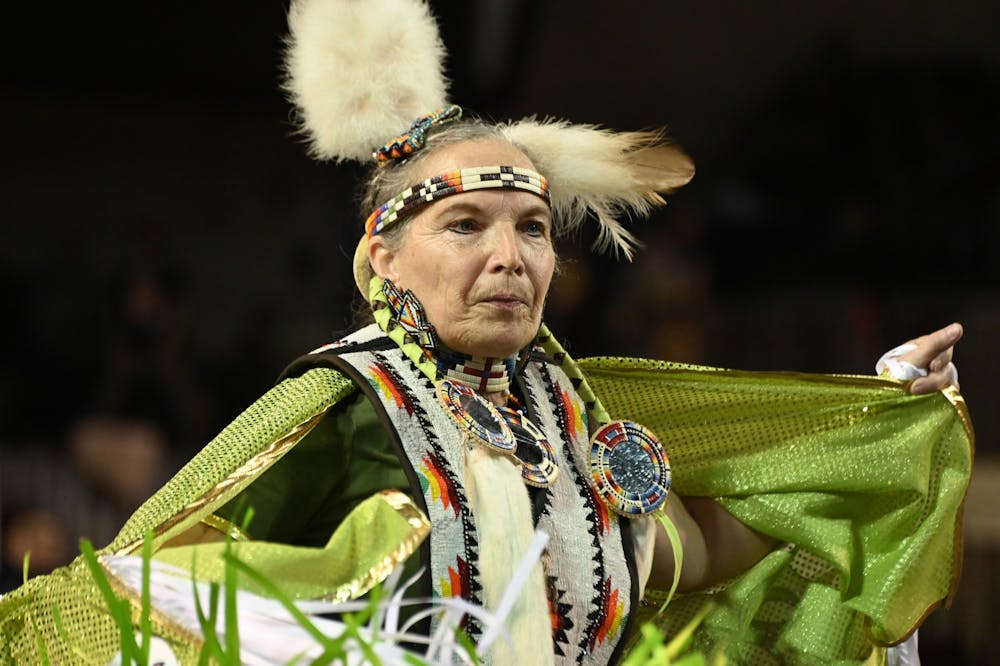Celebrating Life: CMU hosts 34th annual Powwow
The smell of frybread and the sound of drumming echoed through McGuirk Arena on March 18 and 19 as Central Michigan University hosted the 34th annual Celebrating Life Powwow.
Powwows have been an important part of many Native American cultures for quite some time, with the first recorded intertribal powwow having taken place in the late 1800s.
What powwows look like and mean have changed with time. While today it acts as a public gathering event for the tribal and public communities, as well as for members of various tribes to come together to celebrate culture and, depending on the type of powwow, compete in various dancing and drumming categories.
While members of the Saginaw Chippewa Indian Tribe were in attendance, various people competed from tribes across the U.S. and Canada. The Master of Ceremonies, Paul Syrette, is from the Batchewana First Nation in Ontario.
Reagan Recollet, a freshman member of The North American Indigenous Student Organization and volunteer at the powwow talked about how a powwow can impact the community at large.
“Having the opportunity to have people, not only from the Great Lakes region, but from states as far as Oklahoma, even many from the contemporary lands of Canada to join, aside from our tribal community members and our indigenous partners," Recollet said. "It's very, very nice to see how powwow can really bring together the community.”
Throughout the event, drum groups switched out between each round of dancing.
While this was a community event to bring people together, there was a competitive aspect to it as well. Judges rated different drum groups and dancers on theirs performances. The competition was split into age categories for dancers, which were youth, teen, adult and golden age (participants over the age of 50).
The top 3 participants from each category received cash prizes for their dancing or drumming.
The powwow was put on by the CMU Powwow Committee with help from the Native American Student Alliance, Native American programs and other faculty and Saginaw Chippewa tribal community members.
Additionally, student volunteers aided in putting the event on and keeping it running smoothly.
Volunteers aided during the powwow, from admission to assisting in vendor tear down after the event and more.
Vendors at the event sold a variety of goods, including traditional works of art, different kinds of clothing, food and more.
Eduardo Dominguez, a junior, volunteered at the powwow.
“A lot of indigenous things have been commercialized by non-indigenous people," Dominguez said. "So it was nice to go to vendors that are taking that over again, it's like stuff that they have been doing for ages right? So like dream catchers, for example. Seeing (what) they do like as a hobby that they turn into a livelihood. I think it's much more authentic.”
Brandy Rodriguez, a freshman who volunteered at the powwow, said it was important for the powwow to be open to the public.
“People get to see what it actually is rather than like what it's portrayed as in media,” Rodriguez said.
According to “Through Indian Eyes” by Reader's Digest Association, powwows weren't open to non-tribal members until around the mid-1900s
Janay Johnson, a graduate student who volunteered at the powwow, also said it's important for powwows to be open to the public.
“I think they (non-native people) need to be educated," Johnson said. "I feel like it's especially important for the community to see and understand and respectfully learn.”
Through Indian Eyes also said powwows grew in size and number in the 1960s and 70s. Dance styles and regalia also evolved, blending details and traditions drawn from many tribes.
At the same time as the powwows were growing, the American Indian Movement was taking place, bringing challenges Native American communities have faced, and consequently some aspects of Native cultures to public attention.
“The way things were initially, especially with the boarding schools that were still up, (holding a powwow is) just a really important testament to what they do," Johnson said.




